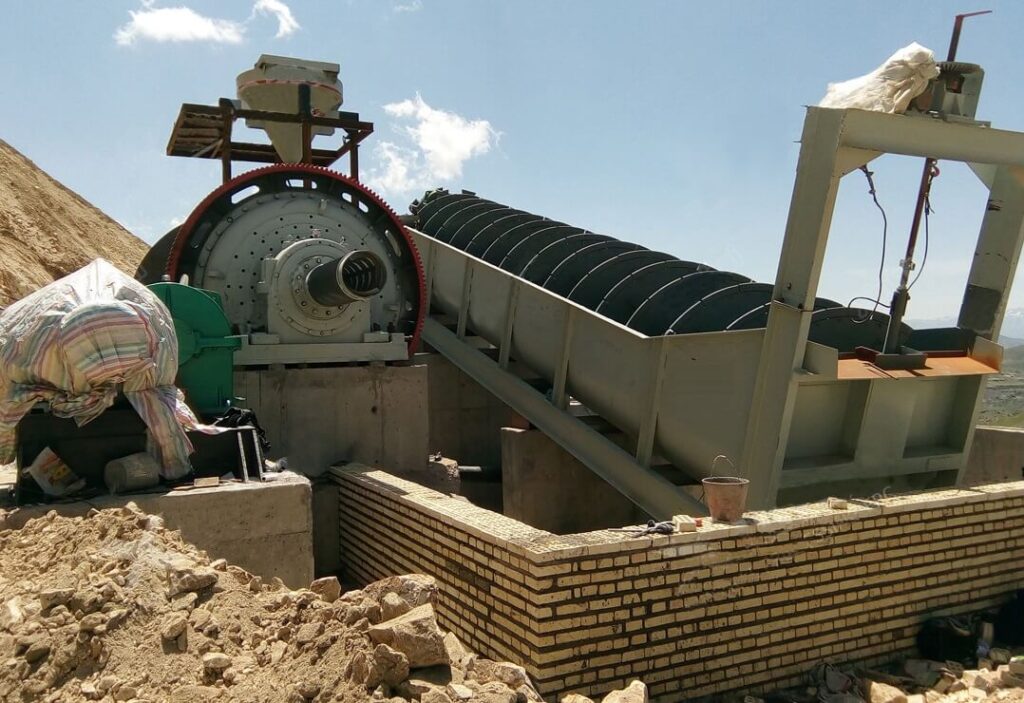The spiral classifier is commonly used in mineral processing (sand washing) equipment. It is often paired with a ball mill to form a closed-circuit circulation for ore diversion. It is also used in gravity concentrators to classify ore and fine mud, as well as in metal mineral processing processes for particle size classification, desliming, dehydration, and other operations during mineral washing. The classifier has a long longitudinal axis installed in an inclined semicircular groove with rotating blades on the axis. The upper transmission mechanism drives the rotation, while there is a spiral lifting device at the lower part.
The spiral classifier operates based on the principle that solid particles of different sizes and specific gravities have varying settling speeds in liquid. Fine ore particles float and overflow in water, while coarse ore particles sink to the tank bottom and are pushed upward by the spiral before being discharged. This device serves mechanical grading purposes by filtering powder ground from the mill, screwing coarse material into the feed port using a spiral blade, and discharging filtered fine material through an overflow pipe.
Importance of Spiral Classifier in Mineral Dressing
Spiral classifiers are essential for mineral dressing operations as they help achieve desired product quality and recovery rates. Their ability to classify and separate particles based on size and density is crucial for efficient extraction and processing of valuable minerals from ore. The importance of spiral classifiers in mineral processing is demonstrated by the following:
Particle Size Classification: Separating particles of different sizes is often necessary in mineral processing. Spiral classifiers classify particles based on size, ensuring the desired particle size range is achieved in downstream processes. This is vital in ore grinding and beneficiation processes where particle size distribution can significantly impact subsequent operation efficiency.
Dewatering: Spiral classifiers remove excess water from mineral slurries, aiding concentration of valuable minerals and reducing final product’s water content. This facilitates efficient transportation and further processing.
Desliming: In certain mineral processing applications, particularly with fine-grained ores, removing fine particles or “slimes” from ore slurry is crucial. Spiral classifiers are used for desliming to prevent interference with subsequent processes like flotation or gravity separation.
Density Separation: Spiral classifiers can also separate particles based on density, which is important in processes such as gravity concentration where denser minerals need separation from lighter gangue materials.
Process Efficiency: Proper classification and separation using spiral classifiers enhance overall efficiency of mineral processing operations. By optimizing particle size and concentration, it maximizes yield of valuable minerals while minimizing waste generation and energy consumption.
Types of Spiral Classifiers
A spiral classifier consists of four main types: high dam single spiral classifier, double spiral classifier; submerged single spiral classifier, double spiral classifier. We will introduce them according to their position within the tank and number of spirals.
Position Within Tank
The main component of a spiral classifier is the spiral itself. Based on its position within the tank relative to slurry surface level, there are three types: low dam, high dam, submerged spirals. The low dam spiral classifier is rarely used now, with high dam and submerged spirals being the main types employed.
- Low Dam Spiral Classifier
This type has limited applications nowadays. The overflow dam is positioned lower than the screw axis of the spiral. Due to its small settling area, it can only be used for washing sand ores with minimal mud content and dewatering coarse particles in actual production. It is seldom used in grinding cycles. - High Dam Spiral Classifier
The high dam type refers to a spiral classifier where the overflow dam is higher than the spiral axis but lower than the upper edge of the spiral at its overflow end. There are single and double classifications within this category. This classifier has a smaller settlement area but larger dam size, allowing adjustment of dam height within a certain range to modify settlement area and particle size classification—an important component commonly utilized in grinding cycles for ore classification with an overflow particle size ranging from 0.83mm to 0.15mm.
3.Submerged Spiral Classifier
The submerged type features 4-5 spiral blades located at the end of the overflow dam, all immersed in pulp. It also includes single and double spirals variations.The classifier possesses a large settlement area and deep classification pool; hence, surface agitation by spirals minimally affects pulp surface resulting in stable classification surface with significant fine-grained overflow output.Its application lies in ore classification with an overflow particle size between 0.15mm to 0.07mm.The submerged spiral classifier often serves as classified equipment for fine or secondary grinding processes within mineral processing plants.
Number of Spirals
Spiral classifiers are categorized into single-spiral classifiers and duplex (double) spiral classifiers based on number of spirals present.Their performance remains similar; however, duplex screw classifiers have greater processing capacity making them suitable for use alongside large-scale grinding machines.Spiral classifier specifications are expressed through their respective spiral diameters.

The spiral classifier is a commonly used solid particle classification equipment to classify and separate materials according to particle size. It has a simple structure, reliable operation, and convenient function. You can contact us for parameters and quotations if you need a spiral classifier.

